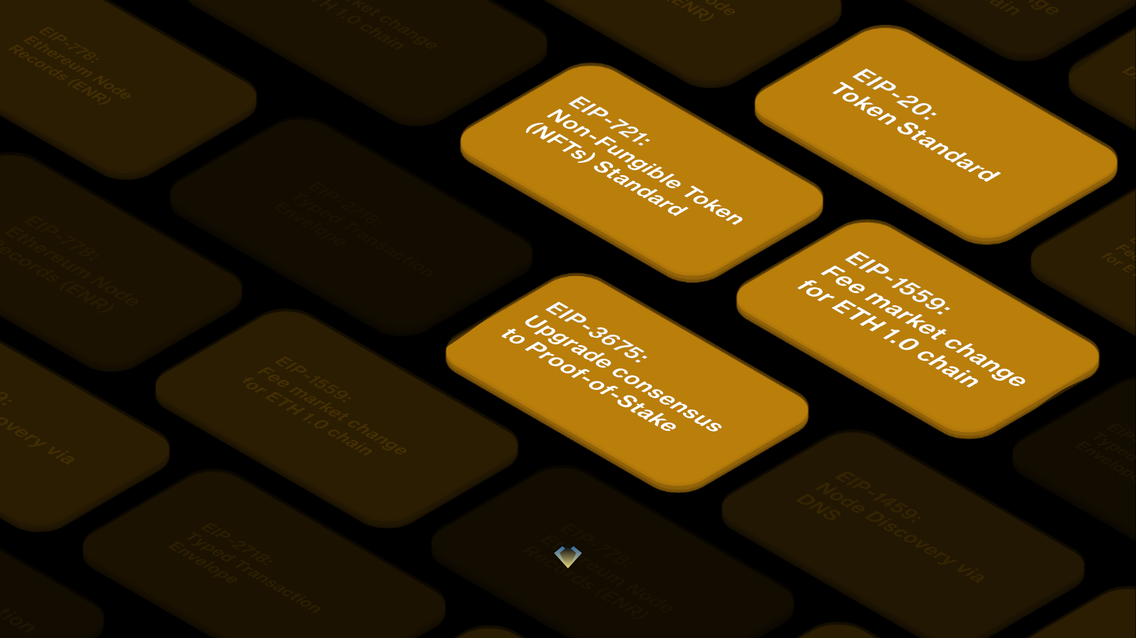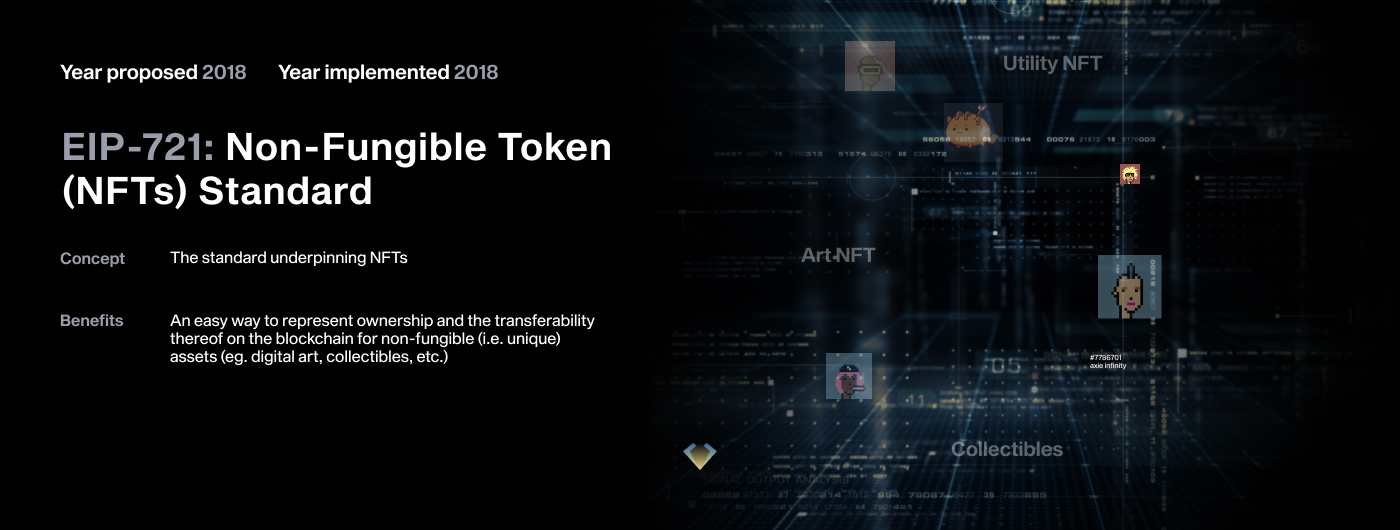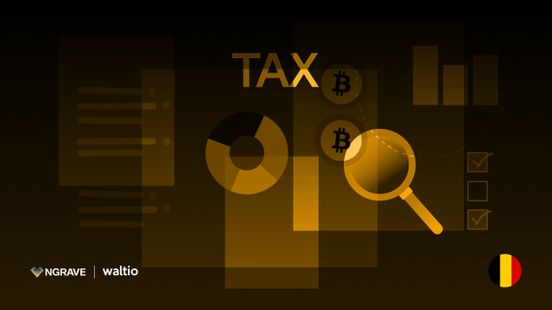

Top Ethereum Improvement Proposals (EIPs) Explained
What do core protocol specifications, client APIs, and contract standards have in common? They’re all standards for the Ethereum platform, huddled together beneath an umbrella embossed with the words Ethereum Improvement Proposals (EIP).
- Article Quick Links:
- A Short History of EIPs
- EIP-20: Token Standard
- EIP-721: Non-Fungible Token Standard
- EIP-1559: Fee market change for ETH 1.0 chain
- EIP-3675: Upgrade consensus to Proof-of-Stake
EIPs are intrinsic to the blockchain’s evolution, and every network upgrade comes with its own batch of proposals — modifications to algorithms that calculate gas fees; implementations that improve transaction functionality or increase mining difficulty; changes to the platform’s monetary policy.
In essence, EIPs are refinements to the core blockchain that must be implemented by each Ethereum client on the network in order to maintain consensus. So, how did Ethereum Improvement Proposals come about? Who can propose them, and how do they get approved? And which EIPs are considered historic in the context of Ethereum’s journey to this point?
A Short History of EIPs
The appearance of the Ethereum Improvement Proposals Github repository is sandwiched between the publication of Vitalik Buterin’s original Ethereum paper (2013) and the launch of the project itself (2015).
Considered one of the most consequential events in the blockchain’s history, the repository was founded in October of 2015 by a crack team of core developers that included Vitalik Buterin, Martin Becze and Hudson Jameson. “The EIP should provide a concise technical specification of the feature and a rationale for the feature,” read the first ever entry, credited to Becze and Jameson. “The EIP author is responsible for building consensus within the community and documenting dissenting opinions.”
The post described three types of EIP: A Standards Track EIP that covered changes affecting most or all Ethereum implementations (those requiring a consensus fork, for instance, or changes to transaction validity rules); a Meta EIP that applied to areas other than the Ethereum protocol itself (procedures, guidelines, changes to development tools); and an Informational EIP, which rather than propose new features, supplied general guidelines or information to the wider Ethereum community.
The first ever EIP, published a month after the repository appeared, fell into the Standards Track category and was advanced by Vitalik. EIP-2: Homestead Hard-fork Changes proposed, among other things, that the gas cost for creating contracts via transactions be increased from 21,000 to 53,000. Since then, hundreds of EIPs have been published, debated and implemented with some later withdrawn.
Although anyone can theoretically propose an EIP, the technical bar is quite high. Once uploaded to Github, EIPs are scrutinized by community members who decide whether they are to be implemented in a future upgrade.
All EIPs — including those currently being reviewed — are available to view online. Without further ado then, let’s take a look at some of the biggest EIPs to be written so far.
EIP-20: Token Standard

ERC-20 introduced a monumental blueprint for creating and issuing smart contracts on Ethereum, and when published in November of 2015, the network was less than five months old.
Proposed by Vitalik and LUKSO founder Fabian Vogelsteller, EIP-20 provided the basic functionality needed to “transfer tokens, as well as allow tokens to be approved so they can be spent by another on-chain third party.”
While many alternative token standards have emerged in the intervening years, the ERC-20 template underpins the majority of tokens currently in circulation, as well as the market’s most-used stablecoins Tether (USDT) and USD Coin (USDC). Making EIP-20 one of the most important upgrades in the blockchain’s history.
EIP-721: Non-Fungible Token Standard

In January of 2018, the crypto world was in the midst of an earth-shaking sell-off as the bloated ICO bubble finally burst. Coincidentally, it was the same month a quartet of ethereum devs conspired to publish EIP-721, which advanced a standard interface for non-fungible tokens (NFTs).
The standard provided the “basic functionality to track and transfer NFTs,” with the devs noting that they had considered a diverse universe of assets — but “we know you will dream up many more.” You would struggle to find a more prescient comment in the entire EIP archives: the NFT market has exploded over the past 18 months, and there’s every reason to believe this year’s sales will exceed $5 billion.
EIP-721 introduced a means by which wallet/broker/auction applications could work with NFTs on the Ethereum network, and reading through the EIP, it’s clear the authors had a good idea of the important role non-fungible tokens would one day play in the ecosystem.
EIP-1559: Fee market change for ETH 1.0 chain

Part of the highly anticipated London Hard Fork, EIP-1559 sought to alter the monetary policy of Ethereum by addressing how the fee market works on the network. The goal was to stabilize transaction fees by introducing both a minimum base fee per gas unit and a fee burning mechanism.
Rather than being a simple UX update, EIP-1559 represented an economic update for the network’s native asset. Ostensibly, the proposal meant that base fees would be burned rather than paid to miners, reducing the overall supply of ETH and creating deflationary pressure on the asset. Indeed, within a month of its implementation over 200,000 ETH had been burned — equivalent to $675 million!
Although detractors claimed EIP-1559 would cause a mass exodus of disgruntled Ethereum miners, FUD wasn’t evident in the markets: on the contrary, ETH’s spot price rose by almost 25% in the 30 days following its implementation.
EIP-3675: Upgrade consensus to Proof-of-Stake

Although prefaced by a warning — “This EIP is not recommended for general use or implementation as it is likely to change” — EIP-3675 is clearly one of the most momentous proposals in Ethereum’s history.
The upgrade, authored by Vitalik, Danny Ryan and Mikhail Kalinin, “specifies the set of changes to the block structure, block processing, fork choice rule and network interface” introduced by the blockchain’s long-awaited transition from a Proof-of-Work (PoW) consensus to the more eco-friendly Proof-of-Stake (PoS).
In short, it doesn’t get any bigger as Ethereum devs work towards the merging of the Ethereum Mainnet with the Beacon Chain, the coordination mechanism of the new network. Serenity, aka Ethereum 2.0, is a multi-phased upgrade that aims to usher in “an efficient, global-scale, general-purpose transactional platform while retaining high crypto-economic security and decentralization.”
Published in July 2021, EIP-3675 finally put flesh on the bones of that idea while kicking the community’s excitement into higher gear.
Speaking of Ethereum 2.0, its continued roll-out sets the scene for some truly innovative proposals from a community that, after all, has never been bigger. One can only imagine the sort of submissions that will be rolling out of the ideas factory in five or ten years. Perhaps, by then, Eth 2.0 will have made way for the blockchain’s third instalment…
Article Quick Links:
- A Short History of EIPs
- EIP-20: Token Standard
- EIP-721: Non-Fungible Token Standard
- EIP-1559: Fee market change for ETH 1.0 chain
- EIP-3675: Upgrade consensus to Proof-of-Stake

Ruben is a repeat tech entrepreneur. His focus is on digital asset security and financial empowerment. He is co-founder and CEO of NGRAVE, the creator of “ZERO” - the world’s most secure hardware wallet for crypto storage. In 2021, he was selected for Belgium’s 40 under 40. Before that, he was a finalist in scale-ups.eu’s Disruptive Innovator of the Year 2020 Award, and nominated in Google/PWC/Trends’ Digital Pioneer 2020.

